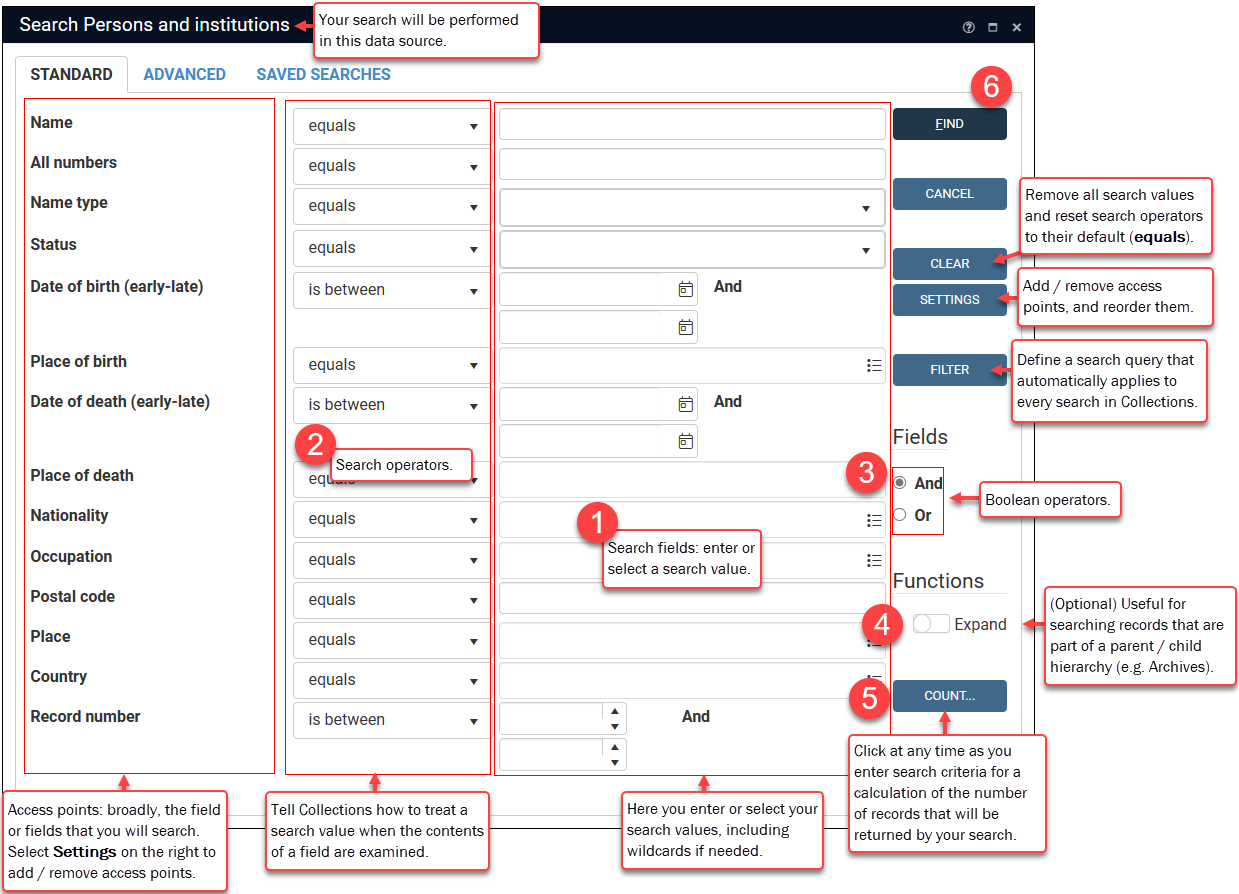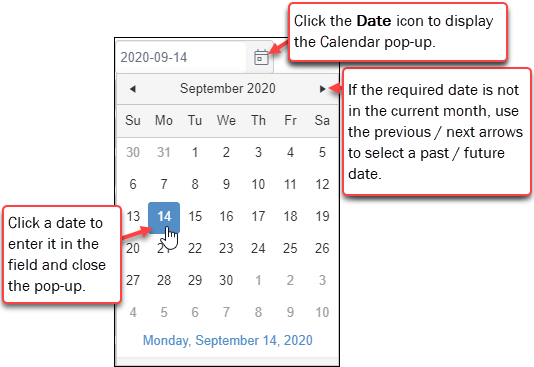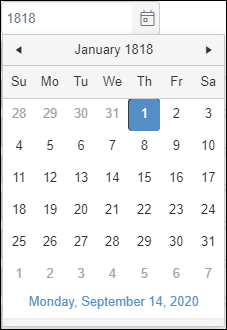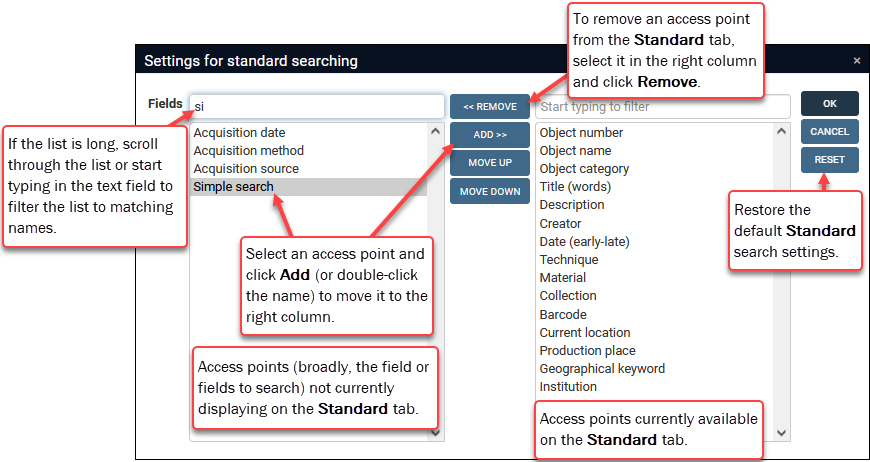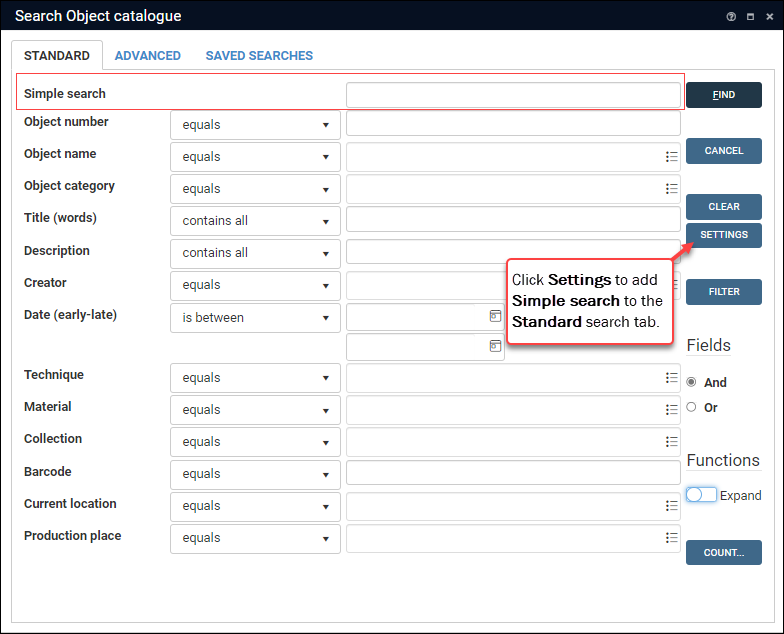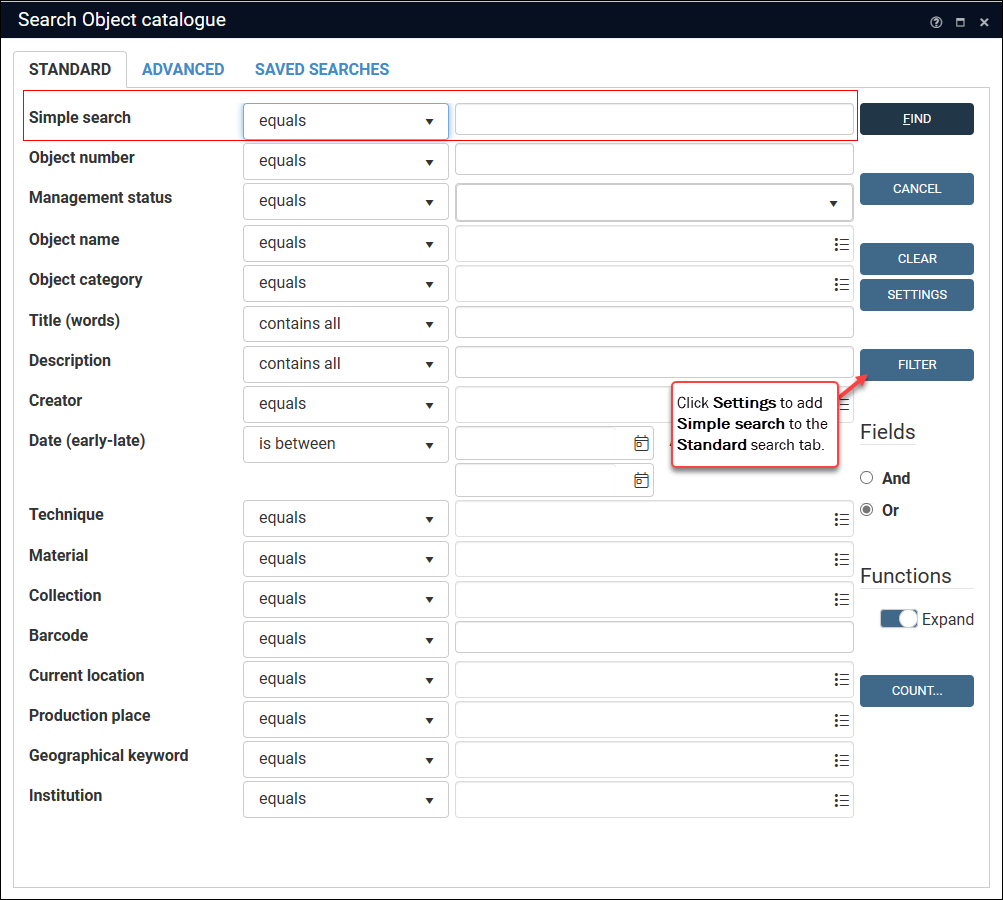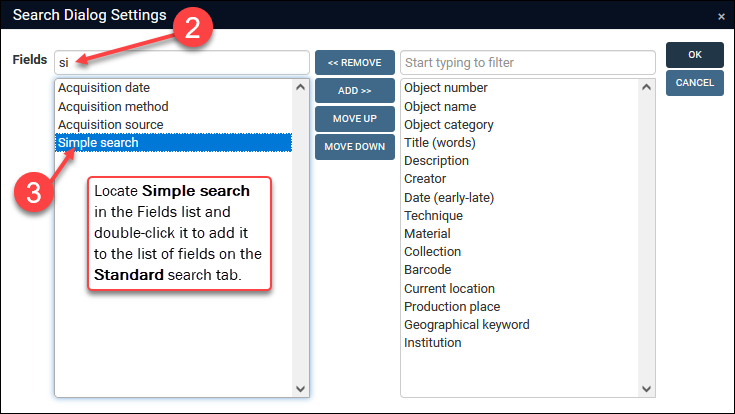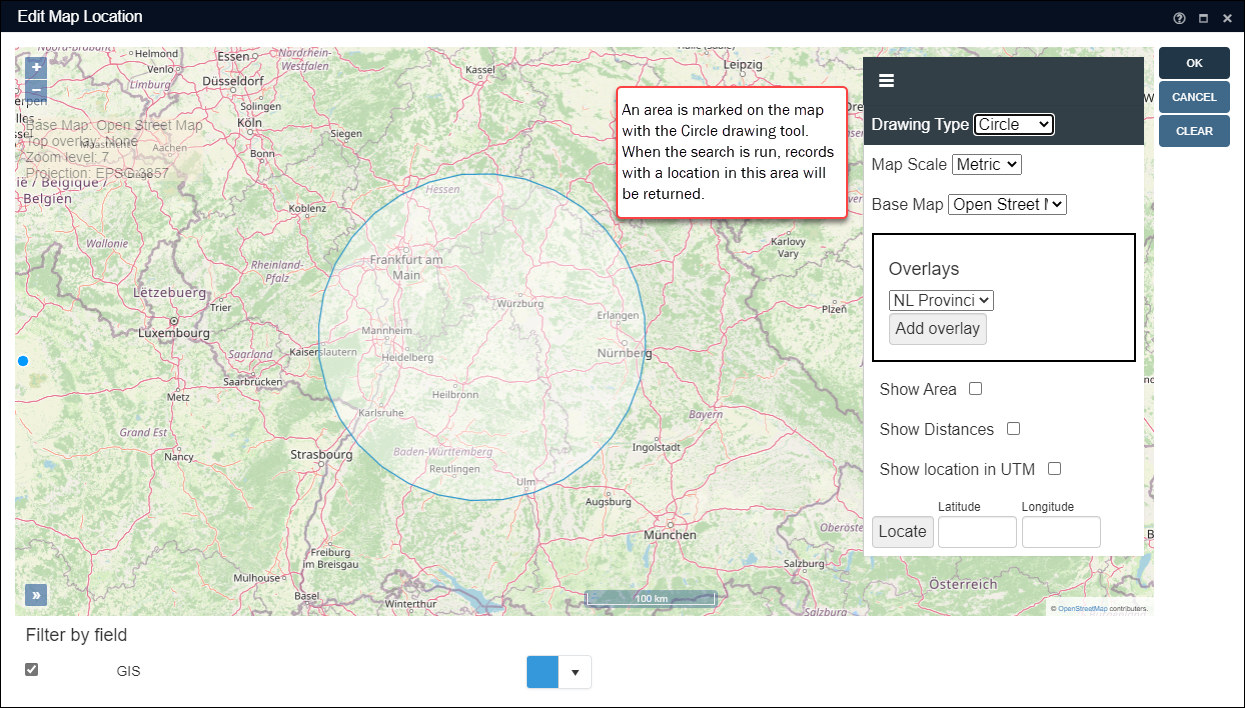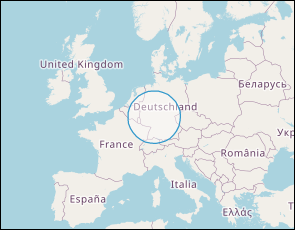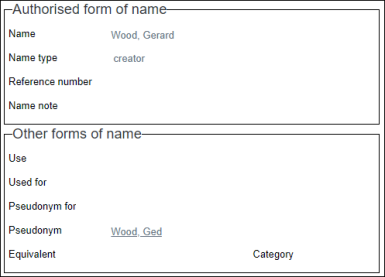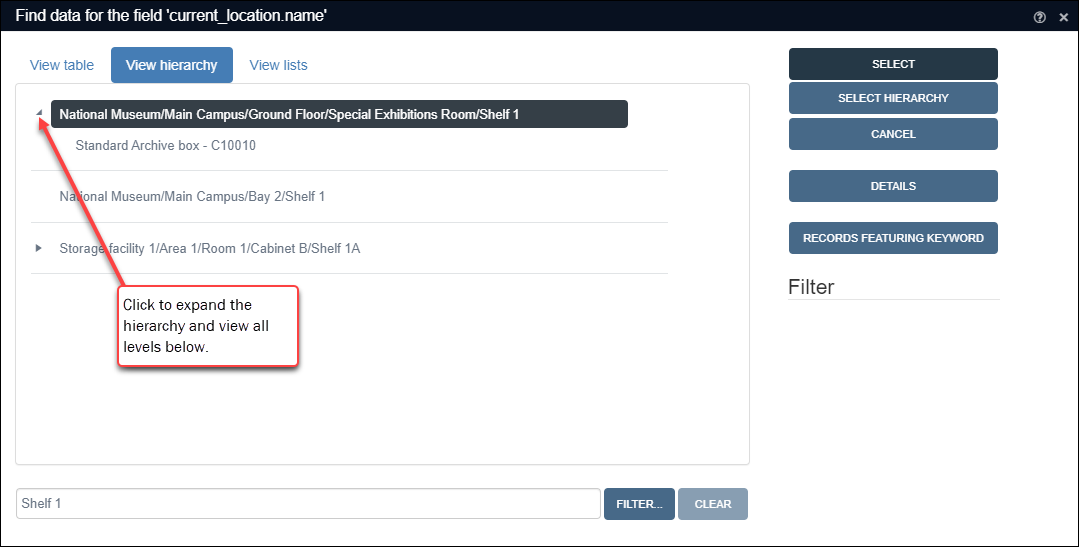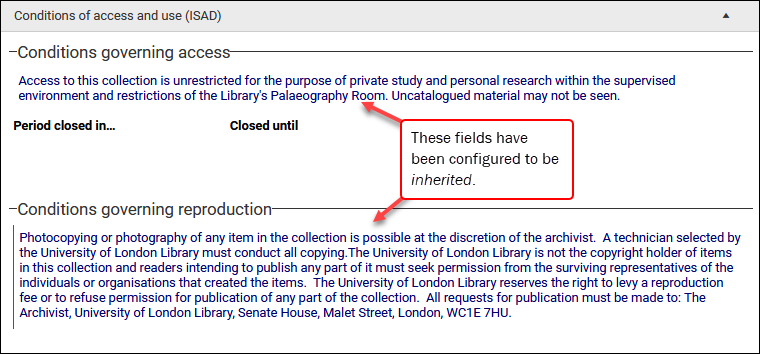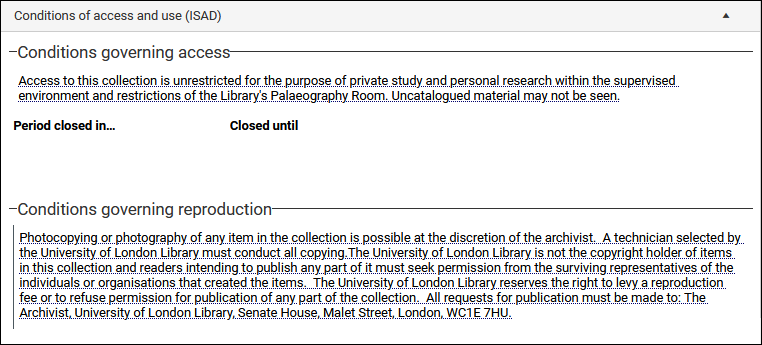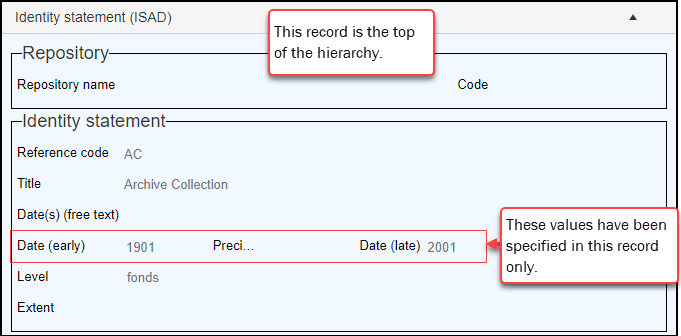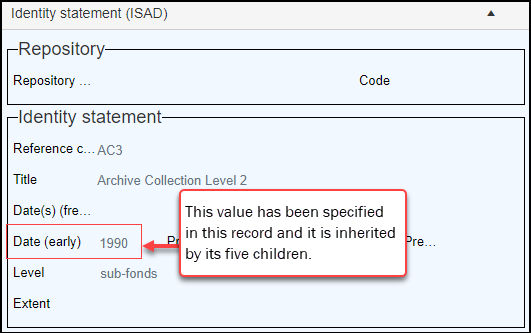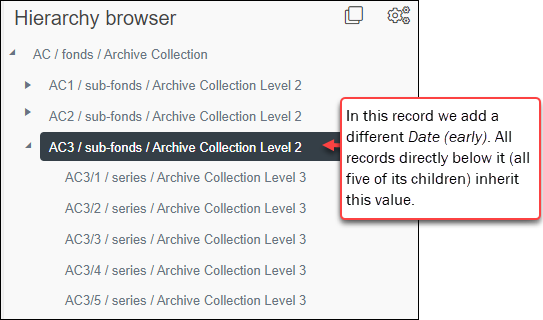Standard search
- Enhanced Phrase searching
Axiell Designer
 A tool for designing, creating, customizing and managing Axiell Collections applications and databases, broadly speaking, the Axiell Collections Model Application. As well as managing databases, including user access and permissions, Designer is used for such tasks as translating field labels, tooltips, values in drop lists, etc. version 7.8 provides Application Administrators with an option to implement Full Text indexing in Collections 1.14 onwards. If implemented, this can improve search performance in long text fields, fields with unique terms, fields with non-unique terms and Linked fields
A tool for designing, creating, customizing and managing Axiell Collections applications and databases, broadly speaking, the Axiell Collections Model Application. As well as managing databases, including user access and permissions, Designer is used for such tasks as translating field labels, tooltips, values in drop lists, etc. version 7.8 provides Application Administrators with an option to implement Full Text indexing in Collections 1.14 onwards. If implemented, this can improve search performance in long text fields, fields with unique terms, fields with non-unique terms and Linked fields A type of field used to link one record to another. A Linked field is a drop list of values (records that the field can link to). When a link is made, the field stores a reference to the linked record (a linkref).; it also provides the ability to perform phrase searching (contains phrase and does not contain phrase) in such fields. Details here.
A type of field used to link one record to another. A Linked field is a drop list of values (records that the field can link to). When a link is made, the field stores a reference to the linked record (a linkref).; it also provides the ability to perform phrase searching (contains phrase and does not contain phrase) in such fields. Details here. - Expand
Collections version 1.13 onwards makes an Expand search implicit whenever a search of an inherited field is performed and it is no longer necessary to enable the Expand option when performing a Standard search or to apply the Expand operator when performing an Advanced search when searching inherited fields.
If an implicit Expand search on inherited fields is undesirable, it can be switched off by those with access to the Collections
settings.xmlfile by including the following setting:<Setting Key="DefaultExpand" Value="false" />
With this setting, the Expand operator will need to be used explicitly when searching inherited fields (as it is in versions of Collections prior to 1.13).
- Fixed queries
A fixed query access point
 An access point is a user-friendly way to search a field or combination of fields or to execute a search statement (known as a fixed query). Access points are found on the Standard tab of the Search box and most often comprise a label (naming the field / fields to be searched) and a search field in which you enter or select a value to search for. Only indexed fields can be set up as access points (an index is a database table designed to speed up the search of frequently queried fields; it only contains values from a field and the id number of the records in which that value appears). Non-indexed fields can be searched on the Advanced search tab. is a complete search statement possibly querying multiple fields. Users either select a checkbox on the Standard search tab to activate the query or can be required to provide a search value. Details about configuring fixed queries can be found in the Axiell Designer Help.
An access point is a user-friendly way to search a field or combination of fields or to execute a search statement (known as a fixed query). Access points are found on the Standard tab of the Search box and most often comprise a label (naming the field / fields to be searched) and a search field in which you enter or select a value to search for. Only indexed fields can be set up as access points (an index is a database table designed to speed up the search of frequently queried fields; it only contains values from a field and the id number of the records in which that value appears). Non-indexed fields can be searched on the Advanced search tab. is a complete search statement possibly querying multiple fields. Users either select a checkbox on the Standard search tab to activate the query or can be required to provide a search value. Details about configuring fixed queries can be found in the Axiell Designer Help. - Indexing fields
Details about indexing fields and the impact on searching can be found in the Axiell Designer Help.
- Partial date searches
Partial date searching requires that a date field has been set to DateIso. Details can be found in the Axiell Designer Help.
Note that DateIso fields can have a Date completion property set, which will auto-complete a date in a Date range search where a year only or month and year have been recorded (for example, if a date of 1937-03 has been recorded, it will be indexed as 1937-03-01 if it is the start of a date range or 1937-03-31 if it is the end of the date range). This is explained in detail here.
In this case, a partial date search of:
dating.date.start from 1937 And dating.date.start to "1937-03"
will return a record with a date of 1937-03-01, which may not be expected. For this reason it is recommended that users always specify a full date when performing a date range search.
- Period type fields
Details about implementing the Period field type can be found in the Axiell Designer Help.
- Phonetic search
Details about configuring non-linked text and free-text fields for phonetic searching can be found in the Axiell Designer Help.
- Searching for special characters
Collections 1.15 provides an option to improve searches where values include special characters. When implemented, it is possible to perform a search for values with or without the special characters.
To be available, an update procedure must be run in databases where Full Text indexing has already been implemented. Details here.
- <Simple search>
For each data source it is possible to configure a Simple search method in Axiell Designer
 A tool for designing, creating, customizing and managing Axiell Collections applications and databases, broadly speaking, the Axiell Collections Model Application. As well as managing databases, including user access and permissions, Designer is used for such tasks as translating field labels, tooltips, values in drop lists, etc. which allows a search to be performed across multiple indexed fields simultaneously. When configured for a data source, the <Simple search> option is added to the Search drop list in Result set View and users are also able to add the Simple search option to the Standard search tab1. Details here.
A tool for designing, creating, customizing and managing Axiell Collections applications and databases, broadly speaking, the Axiell Collections Model Application. As well as managing databases, including user access and permissions, Designer is used for such tasks as translating field labels, tooltips, values in drop lists, etc. which allows a search to be performed across multiple indexed fields simultaneously. When configured for a data source, the <Simple search> option is added to the Search drop list in Result set View and users are also able to add the Simple search option to the Standard search tab1. Details here.
When searching in a multilingual Collections system a search is run across all data in all available languages irrespective of the selected Data language: if the Data language is English and you search for titles containing the word gift, any record with a title in any language that contains the word gift will be returned.
With an Advanced search it is possible to restrict your search to a specific language. Details here.
The Standard tab provides a simple form for searching indexed fields![]() An index is a database table designed to speed up the search of a frequently queried field (it only contains values from the field and the id number of records in which that value appears). The quick search option in the Result set View toolbar and the Standard search tab only search indexed fields. Non-indexed fields can be searched in an Advanced search, but these searches are slower as the search engine checks the full contents of each record for the search value. in a data source. The tab contains a series of access points: these typically comprise a label (naming the field / fields to be searched) and a search field in which you specify a value that will be searched for. An access point is a user-friendly way to search an often used field (e.g. Record Number) or combination of fields (e.g. Simple search), or to execute a search statement (called a fixed query
An index is a database table designed to speed up the search of a frequently queried field (it only contains values from the field and the id number of records in which that value appears). The quick search option in the Result set View toolbar and the Standard search tab only search indexed fields. Non-indexed fields can be searched in an Advanced search, but these searches are slower as the search engine checks the full contents of each record for the search value. in a data source. The tab contains a series of access points: these typically comprise a label (naming the field / fields to be searched) and a search field in which you specify a value that will be searched for. An access point is a user-friendly way to search an often used field (e.g. Record Number) or combination of fields (e.g. Simple search), or to execute a search statement (called a fixed query![]() A fixed query is an access point on the Standard search tab (an access point is a user-friendly way to search across one or more fields). Although it can look like any other access point that queries a single field (e.g. Record number), a fixed query is a complete search statement that can query multiple fields. A label will indicate the scope of the query (e.g. Issued and overdue). Two types of fixed query access point can be added to the Standard search tab: one requires no search value (it is activated by ticking a checkbox in Collections 1.16 onwards or entering an asterisk in the search field in earlier versions); the other requires some value to be entered in the search field.). Enter a search value in one or more search fields, take advantage of search operators to control how a search term is treated in a field (equals, does not equal, contains, etc.); as well as Boolean operators (AND, OR) to determine whether a record has to meet all requirements specified to be returned by the search:
A fixed query is an access point on the Standard search tab (an access point is a user-friendly way to search across one or more fields). Although it can look like any other access point that queries a single field (e.g. Record number), a fixed query is a complete search statement that can query multiple fields. A label will indicate the scope of the query (e.g. Issued and overdue). Two types of fixed query access point can be added to the Standard search tab: one requires no search value (it is activated by ticking a checkbox in Collections 1.16 onwards or entering an asterisk in the search field in earlier versions); the other requires some value to be entered in the search field.). Enter a search value in one or more search fields, take advantage of search operators to control how a search term is treated in a field (equals, does not equal, contains, etc.); as well as Boolean operators (AND, OR) to determine whether a record has to meet all requirements specified to be returned by the search:
- If you initiated a search by selecting Search (F7) in the top Toolbar, the Search box will contain options for fine-tuning the previous search (Widen, Narrow, Exclude). Details here.
- With the Filter option2 it is possible to limit all your searches to a subset of records. Details here.
Running a search on the Standard tab can be as simple as entering a value in a search field and pressing Find.
To locate all records in Persons and institutions where the Name field (name (BA)) includes the name Wood:
- Enter
woodin the Name search field. - Select the contains any search operator from the drop list:

- Select Find or press ENTER to run the search.
Any records where the word
woodappears anywhere in the Name field will be returned by this search.
If you want to list all records in the current data source that you are authorized to access:
- Do not enter any search terms.
- Leave equals in the search operators drop lists
Tip: If necessary, click Clear to remove all search values and reset search operators to their default (equals).
- Click Find.
You have many more options to configure a search on the Standard tab however:
Note: The Standard tab remembers the last search criteria you specified in the current data source![]() The management of a collection can involve a vast amount of information about objects / items / books, people and organizations, events, administration and more. This information is stored as records in data sources. Each data source stores a specific type of information: details about collection items, people, events, loans, and so on.. Be sure to change any search values and conditions that you do not need for your current search; or select the Clear button to remove all search values and reset search operators to their default (equals).
The management of a collection can involve a vast amount of information about objects / items / books, people and organizations, events, administration and more. This information is stored as records in data sources. Each data source stores a specific type of information: details about collection items, people, events, loans, and so on.. Be sure to change any search values and conditions that you do not need for your current search; or select the Clear button to remove all search values and reset search operators to their default (equals).
Note:
- You do not have to enter a value in any of the search fields: when you run the search, all available records in the current data source will be returned.
- You can enter a value in one or in more than one search field.
- Searches are NOT case sensitive: a search for
Woodwill matchWoodandwood; and accents are ignored: for example,amatchesáorÁ. - It is possible to use the normalized form of letters; for example,
aewill matchæ;oewill matchØorœ. - It may also be possible to search for values with or without special characters3. Details below.
- You can use the wildcard characters
*and?to substitute for one or more characters (letters / numbers, etc.) in search values. Details below. - If you need to search on a field that is not available on the Standard tab, select Settings and if the field is listed, add it to the tab (details below). If it is not listed, you will need to perform your search on the Advanced tab.
How you specify a value depends on the type of search field:
|
Search field |
Icon |
Details |
||||||||||||
|---|---|---|---|---|---|---|---|---|---|---|---|---|---|---|
|
No icon |
|
If a search field contains no icons, enter (type / paste) the value you wish to search for into the field:
|
||||||||||||
|
Date |
|
Click the Date icon to display a pop-up calendar and select a date to enter in the field. Selecting a date ensures that it is entered in the correct format. Alternatively, key a date into the field in the required format. The simplest way to enter a date in the correct format is to select a date from the calendar pop-up:
Tip
Alternatively, key a date in the required format into the field. If the format is yyyy-mm-dd, you would enter something like: 2020-01-28 Depending on how your system has been configured by your Application Administrator you may be able to enter partial dates, such as: 2020-12 or Note: If you cannot enter a partial date in a Date field, it may be that the field's Index has not been set to DateIso by your Application Administrator. The simplest way to identify the required format is to select a date from the calendar pop-up: a date in the expected format will display:
|
||||||||||||
|
Period4 |
|
Date periods expressed as a natural language value, such as 12th century, can be saved and searched for in fields with a type of Period. Full details about Period fields can be found here. Although a Period field displays the natural language version of a period, the indexed (searchable) value is stored in the database as an ISO start and end date range (i.e. a numerical value). For example:
When searching a Period field the search value is specified as a complete natural language period, such as 12th century (any years must be specified as digits); do not use single words (not even truncated) from the natural language period (such as century) nor ISO dates with months and/or days. An overview of English natural language period elements that can be entered and subsequently searched for can be found here. Behind the scenes the natural language search value is converted to an ISO date range and matched against the indexed values. Notes:
|
||||||||||||
|
|
Searching for one or more locations involves selecting a geolocation search operator (typically within) and marking a map (specifying an area or location on a map); when the search is run, records with a location in or near the specified area / location will be returned. See Geolocation search operators below for details. |
|||||||||||||
|
Increase / decrease number |
|
This icon appears in a field expecting a number. Key a number in the field and/or click an arrow head to increase or decrease the number in the field. |
||||||||||||
|
|
When specifying a search value in a Linked field
Only records that have already been linked to the search field (creator VV in this example) will be included in the drop list. Note: The drop list does include candidate names and terms (values that do not yet have an approved status). See Status management of terms / names for more details. If the value you are looking for does not appear in the drop list, select the Link Only values currently saved to the field you are searching are listed. Note: Although a maximum of 250 values is listed when the Find data for the Field box is opened in this way, any available value can be selected even if it is not initially listed: start entering characters in the Filter field to list matching values. When searching for a value, the Find data for the field box does not allow you to create a record; in all other ways it is identical to the Find data for the field box that displays when linking records. Details here. Note: When searching a Linked field, a non-preferred term will be substituted automatically for a preferred term (in the same domain). In other words, if your search value is a non-preferred term, the search will actually use its preferred term. More details |
|||||||||||||
|
Read-only list |
|
Click the arrow to display a read-only list of values. Select a value to add it to the field. |
||||||||||||
|
|
Rather than searching a single indexed field, Object name for instance, a fixed query access point
In this case:
|
Using wildcard characters
It is possible to substitute one or more wildcard characters for one or more letters in a search term:
| Wildcard |
Use |
Examples |
|---|---|---|
|
|
Substitutes zero or more characters at its position in a search value. Also known as truncation:
|
appl* will match words starting with appl, e.g. apple, application, applied, etc. paint* will match words starting with paint, e.g. paint, paints, painter, painting, etc. The
When you select the equals search operator, more often than not you will employ the |
|
|
Substitutes for any single character at its position in a search value. |
appl? will match apply and apple (but not apples). organi?e will match organise and organize. ??? will match any combination of three characters. |
Tip: These two wildcard characters can be used in combination with each other.
When configured by your Application Administrator, certain special characters (listed below) can be omitted from a search value6.
Without the update, it is necessary to know the exact spelling of a name like O'Toole, Peter, for example, and to include the single quote and comma in the search value in order to have a precise match:
"O'Toole, Peter"
And if a value includes brackets, hyphens, and so on, it is necessary to include those characters in the .
With the update, it is possible to perform a search for values with or without the special characters; furthermore, it is possible to use the normalized form of letters (for example, ae will match æ; oe will match Ø or œ).
A space is not considered a special character so must be included in search values comprising multiple terms, but when this option is implemented O'Toole, Peter will be matched by any of the following:
- "
O'Toole, Peter" - "
OToole Peter" - "
O'Toole Peter" - "
otool peter" otool*
Following the update, the following characters or combinations of characters can be omitted when searching a Full Text indexed database:
[
]
;
,
!
@
(
)
|
{
}
<
>
?
\r
\n
\t
`
-
=
\\
.
/
~
#
$
%
^
&
_
+
:
\"
\'
*
You will note that the * and ? are listed as symbols that can be omitted from a search. This is not, of course, in their capacity as wildcards: if you include these characters in your search value, they will continue to behave as wildcards.
However, consider a situation where there are three terms in the Thesaurus: ABCDEF, ABC? and ABC*.
Following the update, a search for ABC* will continue to match all three terms (the * operates as a wildcard character).
A search for ABC however will match ABC? and ABC*.
The exception is uniquely indexed fields (fields which are both indexed and only permit unique values): in this case it is not possible to omit a special character. For example, if a uniquely indexed object number contains a hyphen:
ABC-1234
searching for ABC1234 will not locate the record. The hyphen must be specified for a direct match; alternatively, using a wildcard, e.g. ABC*, will return the record (along with any others where the object number commences with ABC).
Note that searches were already case insensitive, accents were ignored in search values, and ligatures and other special letters could be matched using the normalized version of the character(s). For example:
awill matcháorÁaewill matchæoewill matchØorœ
With the exception of the two wildcard characters (* and ?) it is possible to search for a specific special character (in a Full Text indexed database) in both an Advanced and Standard search.
In an Advanced search it is necessary to enclose the special character in quotes and asterisks. For example, to search for a square bracket:
title = "*[*"
To search for an ellipsis:
title = "*…*"
In a Standard search the enclosing quotes are not required:

A default set of access points![]() An access point is a user-friendly way to search a field or combination of fields or to execute a search statement (known as a fixed query). Access points are found on the Standard tab of the Search box and most often comprise a label (naming the field / fields to be searched) and a search field in which you enter or select a value to search for. Only indexed fields can be set up as access points (an index is a database table designed to speed up the search of frequently queried fields; it only contains values from a field and the id number of the records in which that value appears). Non-indexed fields can be searched on the Advanced search tab. is specified for each data source
An access point is a user-friendly way to search a field or combination of fields or to execute a search statement (known as a fixed query). Access points are found on the Standard tab of the Search box and most often comprise a label (naming the field / fields to be searched) and a search field in which you enter or select a value to search for. Only indexed fields can be set up as access points (an index is a database table designed to speed up the search of frequently queried fields; it only contains values from a field and the id number of the records in which that value appears). Non-indexed fields can be searched on the Advanced search tab. is specified for each data source![]() The management of a collection can involve a vast amount of information about objects / items / books, people and organizations, events, administration and more. This information is stored as records in data sources. Each data source stores a specific type of information: details about collection items, people, events, loans, and so on.. If you wish to search a field that is not available on the Standard tab or you wish to reorder access points
The management of a collection can involve a vast amount of information about objects / items / books, people and organizations, events, administration and more. This information is stored as records in data sources. Each data source stores a specific type of information: details about collection items, people, events, loans, and so on.. If you wish to search a field that is not available on the Standard tab or you wish to reorder access points![]() An access point is a user-friendly way to search a field or combination of fields or to execute a search statement (known as a fixed query). Access points are found on the Standard tab of the Search box and most often comprise a label (naming the field / fields to be searched) and a search field in which you enter or select a value to search for. Only indexed fields can be set up as access points (an index is a database table designed to speed up the search of frequently queried fields; it only contains values from a field and the id number of the records in which that value appears). Non-indexed fields can be searched on the Advanced search tab. on the tab, select Settings:
An access point is a user-friendly way to search a field or combination of fields or to execute a search statement (known as a fixed query). Access points are found on the Standard tab of the Search box and most often comprise a label (naming the field / fields to be searched) and a search field in which you enter or select a value to search for. Only indexed fields can be set up as access points (an index is a database table designed to speed up the search of frequently queried fields; it only contains values from a field and the id number of the records in which that value appears). Non-indexed fields can be searched on the Advanced search tab. on the tab, select Settings:
The Standard tab provides a basic form for searching indexed fields![]() An index is a database table designed to speed up the search of a frequently queried field (it only contains values from the field and the id number of records in which that value appears). The quick search option in the Result set View toolbar and the Standard search tab only search indexed fields. Non-indexed fields can be searched in an Advanced search, but these searches are slower as the search engine checks the full contents of each record for the search value. in a data source. The tab contains a series of access points, most often in the form of a label (naming the field / fields to be searched) and a search field. An access point is a user-friendly way to search an often used field (e.g. Record Number) or combination of fields (e.g. Simple search), or to execute a search statement (called a fixed query
An index is a database table designed to speed up the search of a frequently queried field (it only contains values from the field and the id number of records in which that value appears). The quick search option in the Result set View toolbar and the Standard search tab only search indexed fields. Non-indexed fields can be searched in an Advanced search, but these searches are slower as the search engine checks the full contents of each record for the search value. in a data source. The tab contains a series of access points, most often in the form of a label (naming the field / fields to be searched) and a search field. An access point is a user-friendly way to search an often used field (e.g. Record Number) or combination of fields (e.g. Simple search), or to execute a search statement (called a fixed query![]() A fixed query is an access point on the Standard search tab (an access point is a user-friendly way to search across one or more fields). Although it can look like any other access point that queries a single field (e.g. Record number), a fixed query is a complete search statement that can query multiple fields. A label will indicate the scope of the query (e.g. Issued and overdue). Two types of fixed query access point can be added to the Standard search tab: one requires no search value (it is activated by ticking a checkbox in Collections 1.16 onwards or entering an asterisk in the search field in earlier versions); the other requires some value to be entered in the search field.).
A fixed query is an access point on the Standard search tab (an access point is a user-friendly way to search across one or more fields). Although it can look like any other access point that queries a single field (e.g. Record number), a fixed query is a complete search statement that can query multiple fields. A label will indicate the scope of the query (e.g. Issued and overdue). Two types of fixed query access point can be added to the Standard search tab: one requires no search value (it is activated by ticking a checkbox in Collections 1.16 onwards or entering an asterisk in the search field in earlier versions); the other requires some value to be entered in the search field.).
Select Settings to display the Standard search Settings box, which lists all available access points:
The Standard search tab in each data source has a default set of access points arranged in a particular order. In the Settings box you are able to add or remove access points and rearrange the order. Any changes you make are associated with your user account and recalled by Collections whenever you log in:
-
Locate an access point in the left column and double-click it to add it to the column on the right; this column lists all access points currently included on the Standard tab in the order in which they display.
Note: If you need to search a field that is not listed, you will need to perform your search on the Advanced tab.
-
You can reorder the access points on the Standard tab by selecting a name in the right column and clicking Move up / Move down as required.
A default set of access points![]() An access point is a user-friendly way to search a field or combination of fields or to execute a search statement (known as a fixed query). Access points are found on the Standard tab of the Search box and most often comprise a label (naming the field / fields to be searched) and a search field in which you enter or select a value to search for. Only indexed fields can be set up as access points (an index is a database table designed to speed up the search of frequently queried fields; it only contains values from a field and the id number of the records in which that value appears). Non-indexed fields can be searched on the Advanced search tab. is specified for each data source
An access point is a user-friendly way to search a field or combination of fields or to execute a search statement (known as a fixed query). Access points are found on the Standard tab of the Search box and most often comprise a label (naming the field / fields to be searched) and a search field in which you enter or select a value to search for. Only indexed fields can be set up as access points (an index is a database table designed to speed up the search of frequently queried fields; it only contains values from a field and the id number of the records in which that value appears). Non-indexed fields can be searched on the Advanced search tab. is specified for each data source![]() The management of a collection can involve a vast amount of information about objects / items / books, people and organizations, events, administration and more. This information is stored as records in data sources. Each data source stores a specific type of information: details about collection items, people, events, loans, and so on.. As we see above, it is possible to add / remove access points and to change their order. Changes you make apply to the current data source, are associated with your user account and recalled by Collections whenever you log in.
The management of a collection can involve a vast amount of information about objects / items / books, people and organizations, events, administration and more. This information is stored as records in data sources. Each data source stores a specific type of information: details about collection items, people, events, loans, and so on.. As we see above, it is possible to add / remove access points and to change their order. Changes you make apply to the current data source, are associated with your user account and recalled by Collections whenever you log in.
You can return the Standard search Settings box to its default state by clicking the Reset button7. A message will ask you to confirm the reset:
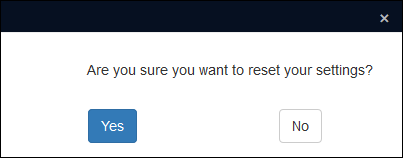
Tip: An option in the Main menu enables you to restore ALL settings you have changed across Collections back to their default. The Reset option in the Standard searchSettings box only affects this box's settings.
Simple search
Depending on your version of Collections8, you may be able to add the Simple search option to the Standard tab; this option enables you to search for a value across multiple indexed fields simultaneously.
The Result set View toolbar includes an option for performing a basic search in the current data source![]() The management of a collection can involve a vast amount of information about objects / items / books, people and organizations, events, administration and more. This information is stored as records in data sources. Each data source stores a specific type of information: details about collection items, people, events, loans, and so on.:
The management of a collection can involve a vast amount of information about objects / items / books, people and organizations, events, administration and more. This information is stored as records in data sources. Each data source stores a specific type of information: details about collection items, people, events, loans, and so on.:
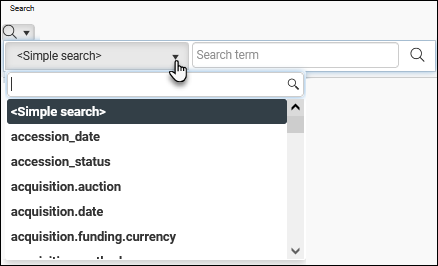
The drop list includes a list of field names and can be configured to include a <Simple search> option that enables searching for a value across multiple indexed fields simultaneously.
Note: In your Collections implementation, a different name might be used for <Simple search>.
When the cursor hovers over <Simple search>, a tooltip will display the field tags![]() A field tag is a unique two character identifier for a field. of all indexed fields that will be searched simultaneously for your search value:
A field tag is a unique two character identifier for a field. of all indexed fields that will be searched simultaneously for your search value:

If the <Simple search> option is available in Result set View, it can also be added to the Standard search tab:
The only operator available for Simple search is contains all (described below); as such, there is no drop list of search operators for Simple search.
Why contains all?
Previously, Simple search employed the equals search operator by default but this was changed to contains all9 as it is less strict than equals and more likely to return matching records especially when you enter multiple search terms in an order that differs from the order in which they are stored in the record (notably personal names, which might be recorded as last name, first name or first name last name): contains all tells Collections to locate the search value anywhere in the search field.
The only operator available for Simple search is equals (described below), and partial search values must therefore be truncated explicitly with the asterisk * wildcard (described above). A search in the Simple search field can of course be combined with a search in any other field available on the Standard tab:

Add Simple search to the Standard search tab as you would any search field:
- Click the Settings button.
- Locate the Simple search option (start entering Simple in the Fields text box to filter the list to matching values).
- Select Simple search in the left column and click Add (or double-click Simple search):
Note: If Simple search is not listed, your Application Administrator will need to configure a Simple search method for the data source.
The Search operators drop list includes commands for fine-tuning the results of your search. A search operator tells Collections how to treat a search value when the contents of a field are examined.
Note: Not all search operators are available for every search field.
|
Operator |
Details |
||||||
|---|---|---|---|---|---|---|---|
|
Depending on how the field you are searching has been indexed, your search value:
A useful and powerful search operator, especially when used in conjunction with the Rule of thumbA Free Text field (notes, description and book titles for instance) can be searched for values found in the field, a single word for instance; when searching a In either case, the creator = wood,* will return any record for creators with the last name Note: equals also performs the same search as the equivalent operator. When a field is indexed its data is copied to a table and optimized for searching; when you search an indexed field, you search the optimized index rather than the field itself. There is more to indexing than that but the key point is that indexing a field makes a search in the field quick and efficient (more details can be found in the Axiell Designer Help). Not all fields in Collections are indexed. When you search a data source For our purposes, a field can be indexed in one of two ways: the entire contents of the field is indexed as a single value or each word in a field is indexed separately. When constructing an equals search some awareness of how a field might be indexed is useful. Short of accessing the Collections data dictionary in Axiell Designer The two types of index are:
|
|||||||
|
Return records that do not include your search value in the search field. The same rules described for equals apply to does not equal. For instance, if you specify two search values in a Free text field, both values must be found in the search field in order for a record to be excluded from the search results; if only one value is found, the record will be returned by this search. |
|||||||
|
is empty |
Return records where there is no value in the search field. If there is more than one occurrence |
||||||
|
is not empty |
Return records where there is a value in the search field. If there is more than one occurrence |
The following only affects data sources without Full text indexing.
Some background: as mentioned above, not all fields in Collections are indexed. When you search a data source![]() The management of a collection can involve a vast amount of information about objects / items / books, people and organizations, events, administration and more. This information is stored as records in data sources. Each data source stores a specific type of information: details about collection items, people, events, loans, and so on. using the Standard tab of the Search box, only indexed fields are made available for searching. For our purposes, a field can be indexed in one of two ways: the entire contents of the field is indexed as a single value, a Text (term) index, or each word in a field is indexed separately, a Free text index.
The management of a collection can involve a vast amount of information about objects / items / books, people and organizations, events, administration and more. This information is stored as records in data sources. Each data source stores a specific type of information: details about collection items, people, events, loans, and so on. using the Standard tab of the Search box, only indexed fields are made available for searching. For our purposes, a field can be indexed in one of two ways: the entire contents of the field is indexed as a single value, a Text (term) index, or each word in a field is indexed separately, a Free text index.
The issue: from Collections 1.16 onwards, the search operator drop list in a Standard search includes the contains all, contains any and contains phrase search operators; at the moment however, when searching fields with a Free text index, contains any and contains phrase behave as contains all, locating the search value anywhere in the search field (it is worth mentioning that contains phrase has in fact always performed a contains all search in Free text indexed fields).
This will be changed in a future release.
Note: Hyphens and other separators are effectively ignored by contains and its variations, so that a search for user friendly will match user friendly and user-friendly.
|
Operator |
Details |
|---|---|
|
contains phrase |
A record will be returned if the exact combination of words in your search value (ignoring case) is located in the search field. A contains phrase search for dollhouse with furniture in the title (TI) field would return records with titles such as Wooden dollhouse with furniture and lights and Dollhouse with furniture, but not Dollhouse with plastic furniture. Tip: It is not possible to truncate terms in a phrase search. |
|
does not contain phrase |
A record will not be returned if the exact combination of words in your search value (ignoring case) is located in the search field. |
|
Operates similarly to equals except that your search value implicitly has left and right truncation with the contains all is less strict than equals and more likely to return matching records especially when you enter multiple search terms in an order that differs from the order in which they are stored in the record (notably personal names, which might be recorded as last name, first name or first name last name). contains all tells Collections to locate the search value anywhere in the search field. For instance:
will match: the, their, there, other, either, etc. As you can see, the This search would achieve the same result:
|
|
|
does not contain all |
Operates similarly to does not equal except that your search value implicitly has left and right truncation with the See contains all. |
|
contains any |
Used when specifying more than one search value in the search field. Operates similarly to equals except that each search value implicitly has left and right truncation with the In this example, only one of the two search values needs to be located in the Title field in order for a record to be returned by the search:
Note that:
|
|
does not contain any |
Used when specifying more than one search value in the search field. Operates similarly to does not equal except that each search value implicitly has left and right truncation with the See contains any. |
|
starts with10 |
Return records where the value in the search fields starts with the specified character(s). Values are implicitly truncated: a search for |
When GIS functionality is enabled in your system, locations are recorded in a Geographical thesaurus Authority data source![]() Authority data sources are used for vocabulary control and they manage the many names and terms referenced by records in almost every other data source. The purpose of a controlled vocabulary is to ensure consistent use of names and terms throughout your records and this is achieved by specifying that a name or term is preferred; then when a non-preferred version of a name or term is selected in a Linked field drop list, it is automatically replaced with the preferred name or term. and location fields throughout Collections can link to a record in this data source. Any of these linked locations in the current
Authority data sources are used for vocabulary control and they manage the many names and terms referenced by records in almost every other data source. The purpose of a controlled vocabulary is to ensure consistent use of names and terms throughout your records and this is achieved by specifying that a name or term is preferred; then when a non-preferred version of a name or term is selected in a Linked field drop list, it is automatically replaced with the preferred name or term. and location fields throughout Collections can link to a record in this data source. Any of these linked locations in the current![]() The record currently displayed in Record details View or highlighted (with a solid background) in Result set View or Gallery View for instance. or selected records will then display on a map (details about geolocation fields and working with maps available here).
The record currently displayed in Record details View or highlighted (with a solid background) in Result set View or Gallery View for instance. or selected records will then display on a map (details about geolocation fields and working with maps available here).
Depending on how your system has been set up, it may be possible to search for locations on the Standard tab of the Search box. A searchable GIS field is identified by a map icon:

Searching for one or more locations involves selecting a geolocation search operator (typically within) and marking a map (specifying an area or location on a map); when the search is run, records with a location in or near the specified area / location will be returned.
To search for locations:
- Select a search operator.
-
Click the map icon beside the GIS search field to open the Edit Map Location window.
Use a drawing tool to mark an area / location (spot) on the map (details about using the drawing tools can be found here).
-
Click OK to close the Edit Map Location window.
|
Operator |
Details |
|||||||||||
|---|---|---|---|---|---|---|---|---|---|---|---|---|
|
within |
Use the Circle or Polygon drawing tool to mark an area on the map. When the search is run, records with a location in the specified area / location will be returned: |
|||||||||||
|
intersects |
Mark an area or location (spot) on the map with any of the drawing tools. When the search is run, records with a location that cuts across the marked location will be returned. In this example the Circle tool is used to mark an area on the map:
In our Geographical thesaurus data source we have a record for France and it is returned by this search as it intersects our search area: |
|||||||||||
|
nearest |
One additional field display when nearest is selected. Enter a number and then mark a location on the map:
In this example, the five records for locations closest to the marked location are returned. |
|||||||||||
|
Two additional fields display when the distance search operators are selected. Enter a range in the first and select the units of measurement (Metres, Miles or Kilometres) in the second:
Typically, you would use the Point drawing tool to mark a location on the map from which the distance is calculated. Assuming 50 km is specified as above, a record is returned if its location is:
|
||||||||||||
As the name indicates, Hierarchical operators are intended for searching data sources![]() The management of a collection can involve a vast amount of information about objects / items / books, people and organizations, events, administration and more. This information is stored as records in data sources. Each data source stores a specific type of information: details about collection items, people, events, loans, and so on. in which records are typically organized in a hierarchy of parent / child relationships - Archives and Locations and containers, for instance. They are also used when searching the authority data sources, Persons and institutions, and especially Thesaurus in which the relationship between records can be defined hierarchically via broader and narrower terms.
The management of a collection can involve a vast amount of information about objects / items / books, people and organizations, events, administration and more. This information is stored as records in data sources. Each data source stores a specific type of information: details about collection items, people, events, loans, and so on. in which records are typically organized in a hierarchy of parent / child relationships - Archives and Locations and containers, for instance. They are also used when searching the authority data sources, Persons and institutions, and especially Thesaurus in which the relationship between records can be defined hierarchically via broader and narrower terms.
Some (though not all) of these operators are useful when directly searching a hierarchical data source (e.g. you selected Thesaurus from the Select data source box); typically, however, they are used when searching a data source that is linked to a hierarchical data source (e.g. you are searching the Object catalogue, which is linked to records in an authority data source).
|
Operator |
Details |
||||||||
|---|---|---|---|---|---|---|---|---|---|
|
Search for records higher in the hierarchy than your search value:
|
|||||||||
|
Search for records lower in the hierarchy than your search value:
|
|||||||||
|
Search for the topmost record in the hierarchy in which your search value is located:
|
|||||||||
|
Similar to narrower except that you search for your search value and any records lower in the hierarchy than your search value:
|
|||||||||
|
Can be used to search the Thesaurus and Persons and institutions or a field linked to a record in either of these data sources Specify a term / name as your search value and search for it AND all of its equivalent terms / names. Note: The equals operator performs this same function. |
|||||||||
|
Can be used to search the Thesaurus or a field linked to a record in the Thesaurus where a term has at least one Related Term (related_term (rt)) defined for it. Specify a term as your search value and search for it AND all of its related terms. |
|||||||||
|
Can be used to search the Persons and institutions or a field linked to Persons and institutions where a name has at least one Pseudonym (pseudonym (PS)) defined for it. Specify a name as your search value and search for it AND all of its pseudonyms
This search in Persons and institutions will return two records, the record for Wood, Gerard and Wood, Ged:
If we search a field linked to Persons and institutions, this search will return any record where Creator = Wood, Gerard or Wood, Ged:
|
|||||||||
|
Available when searching any data source To demonstrate the use of hierarchical we search on current location, but the same approach applies when searching archives. Locations are organized in a hierarchy of parent / child records in the Locations and containers data source. Here we see five levels in the locations hierarchy of the National Museum. The top level of the hierarchy is the museum itself; the museum has two sites, the Main Campus and Off-site storage; here we drill down through another three levels on the Main Campus branch of the hierarchy to individual shelves (we could go further and register boxes on shelves for instance): National Museum (NM) Main Campus (NM/MC) Ground Floor (NM/MC/GF) Special Exhibitions Room (NM/MC/GF/SER) Shelf 1 (Shelf 1) Shelf 2 (Shelf 2) Gallery 1 (NM/MC/GF/G1) Shelf 1 (Shelf 1) Shelf 2 (Shelf 2) First Floor (NM/MC/FF) Northend Hall (NM/MC/FF/NH)... Southend Hall (NM/MC/FF/SH)... Off-site storage (NM/OS)... When the Current location of an item in your collection is updated, only the lowest level of the hierarchy (the actual location) is stored in the record in the current_location.name (2A) field:
Although the full hierarchy is pulled dynamically from the location record and displayed below the current location in a merged-in field, this information is not editable or searchable (details about merged-in fields can be found here). A problem arises if the current location is not a unique name, Shelf 1 for instance. As we see in the hierarchy above, there are two locations called Shelf 1 and if we search for Shelf 1, we will return records in both locations, which is unlikely to be our objective. With the hierarchical search operator:
To demonstrate, we search the Object catalogue using the Current location name field:
Note: If the Current location name search field is not included on the Standard tab, you can add it by selecting the Settings button (details below). When specifying the level of the hierarchy you want to search for, you generally do not want to select it from the drop list unless the search value is a unique name:
This will only add a single level of the hierarchy to the search field:
and your search results will include records from every location with this name, which is unlikely to be your objective. If your search value (a current location name for instance) is not unique, it is essential to enter all preceding levels of the hierarchy, but it is best practice in any case to enter all preceding levels of the hierarchy whether the search value is unique or not. To do so, you can of course type the full pathway (assuming you can remember it accurately); alternatively, use the Find data for the field box:
More details
Having entered the level of the hierarchy you want to search for, you can modify the search value to narrow or expand your search results: With the addition of the National Museum (NM) Main Campus (NM/MC) Ground Floor (NM/MC/GF) Special Exhibitions Room (NM/MC/GF/SER) Shelf 1 (Shelf 1) Shelf 2 (Shelf 2) Gallery 1 (NM/MC/GF/G1) Shelf 1 (Shelf 1) Shelf 2 (Shelf 2) First Floor (NM/MC/FF) Northend Hall (NM/MC/FF/NH)... Southend Hall (NM/MC/FF/SH)... Off-site storage (NM/OS)...
Note: If a field is likely to be searched using the |
These search operators are available when searching date, ISO date, integer and numeric fields.
In an ISO date field (Field type = DateIso), your search value can be a partial date: just the year (yyyy) or year followed by a month (yyyy-mm). Details about how to check a field's type here.
|
Operator |
Details |
|---|---|
|
When this search operator is selected, a second entry field is added beside the first allowing you to search the date or number field for a range of values:
Return records where the value in the field you are searching falls entirely or partially within the search range specified. The search range is inclusive of the values entered. In the example above we are specifying: >= 1740 AND <= 1750 A search field, Date (early-late) in the Object catalogue for example, can be configured to search on two separate fields, Date (early) and Date (late):
If you provide:
If the search field is based on a single date, year of publication for instance, and you use the is between search operator to specify a date range, a record will be returned by the search if its date falls between the two dates (inclusive). In this example, a record will be returned if a book's publication date is 2002, 2003 or 2004:
|
|
|
is not between |
As for is between except records are returned if the value in the field you are searching falls outside the search range specified. |
|
less than |
Return records where the value in the search field is:
|
|
less than or equal to |
Return records where the value in the search field is:
|
|
greater than |
Return records where the value in the search field is:
|
|
greater than or equal to |
Return records where the value in the search field is:
|
Application Administrators will find details about implementing the Period data type in the Axiell Designer Help.
Collections 1.15 saw the introduction of the Period field type, making it possible to save and to search for date periods as a natural language value, such as 12th century, Spring 2023, and so on.
Tip: Details about the Period field type (including a definition of the basic elements used to describe a period, and valid formats) can be found here.
When searching a Period type field, we search for a single date period, not date period ranges.
In versions of Collections prior to version 2.0, searching a Period type field is somewhat limited. The default search operator is equals and it is only possible to return records with dates that fall within the period searched for. For example, performing an equals search on a Period type field such as:

will find records in which the field contains dates falling within the spring of 2023; however, performing a wider search on the specified period is not possible as it is only possible to search for a single period, not period ranges.
A range of search operators for Period type fields is available, and descriptive labels are provided for the various Relational operators11:
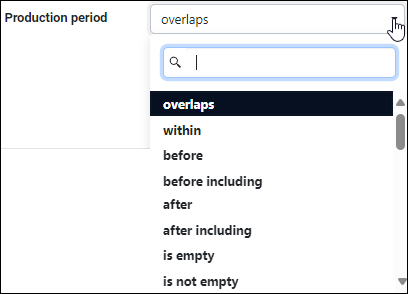
Details:
|
Operator |
Details |
|||||||||||||||||||||
|---|---|---|---|---|---|---|---|---|---|---|---|---|---|---|---|---|---|---|---|---|---|---|
|
Perform a wider search on the specified period by returning any records in which a date intersects with (overlaps) the search date. For example:
will return records with periods such as It is important to understand that Production period overlaps 2000 will not return records earlier than the year 2000 for instance. It is more accurate to describe an In the example above, the date range of Production period overlaps 2000 any period that intersects this range is considered to overlap, and a record with an overlapping period in the search field will be returned:
Note: This operator is also available for Advanced searches, and it is the default operator for Period type access points |
||||||||||||||||||||||
|
Used for A search of:
will return records with periods such as Tip: |
||||||||||||||||||||||
|
after |
Return records where the value in the search field is later than the search period. Used for Tip: For Advanced searches use |
|||||||||||||||||||||
|
after including |
Return records where the value in the search field is later than or the same as the search period. Used for Tip: For Advanced searches use |
|||||||||||||||||||||
|
before |
Return records where the value in the search field is earlier than the search period. Used for Tip: For Advanced searches use |
|||||||||||||||||||||
|
before including |
Return records where the value in the search field is earlier or the same as the search period. Used for Tip: For Advanced searches use |
|||||||||||||||||||||
|
is not empty |
Return records where the search field contains a value. Used for Tip: For Advanced searches use |
|||||||||||||||||||||
|
is empty |
Return records where the search field is empty. Used for Tip: For Advanced searches use |
Notes
- It is possible to use dates in the current interface language / region format.
|
Operator |
Details |
|---|---|
|
sounds like |
Details about configuring non-linked text and free-text fields for phonetic searching can be found in the Axiell Designer Help. Where available, phonetic searching allows you to search a term or free-text field for words that sound like the search value. This can be useful when performing a search in English where regional spelling may be an issue. For example, a search for:
|
If you enter a search value in more than one search field on the Standard tab, you can specify that a record is returned by the search only if it matches every search term specified or only one search term.
Two Boolean operators are available on the Standard tab:
| Boolean operator | Details |
|---|---|
|
AND |
The default option. A record must match all search terms in order to be returned by the search. This Boolean operator typically decreases the number of records found by a search. A search in Persons and institutions for:
The green area indicates which records will result from this search:
A record will only be returned for someone whose name is John and nationality is British. It will not return a record for someone called John whose nationality is American. Tip: If too many records are returned by your search, add another search term with the AND operator. |
|
OR |
A record only needs to match one search term specified in order to be returned by the search. This Boolean operator typically increases the number of records found. A search in Persons and institutions for:
The green area indicates which records will result from this search:
If a record includes both search values, it will be returned by the search, but it only matters that one of the search values is located. A record will be returned for:
Tip: If too few records are returned by your search, add another search term using the OR operator. |
When records can be organized in a hierarchy of parent / child relationships, a field can be configured to be inheritable so that a value added to the field in a parent record will also display in the field in all of its children. This can be extremely efficient as a value only needs to be entered and saved in the parent record to be inherited by all of its children.
Where records can be arranged in a hierarchy, a field can be configured to be inherited so that a record lower in the hierarchy inherits a value entered in a record immediately higher in the hierarchy (its parent). This can be efficient as a value only needs to be entered and saved in the parent record to be inherited by all of its children; importantly, while the value displays in a child record it is not stored in that record (in the child record the field is actually empty until the field is edited and the inherited value is overwritten).
In the following example, the Conditions governing access and Conditions governing reproduction fields are configured to be inherited and data has been added to both fields in a parent record:
When we view a record lower in the hierarchy, the values from the parent record are displayed in these two fields but with a dotted underline to indicate that they have been inherited:
In older versions of Collections an inherited value is a lighter grey than other data. Here we see the Archival history field in a parent record:
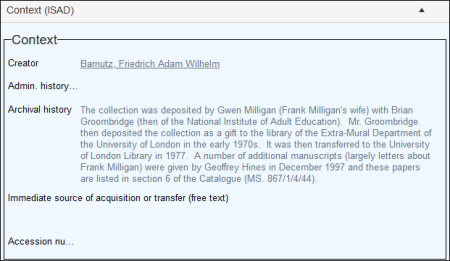
When we view a record lower in the hierarchy, the Archival history value is faded to indicate that it has been inherited:
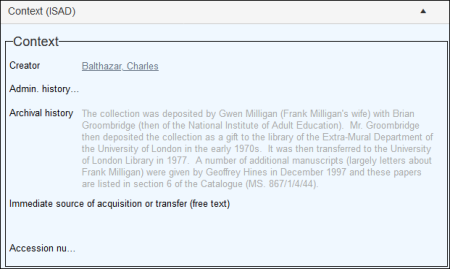
An inherited value can be edited or deleted in the current record![]() The record currently displayed in Record details View or highlighted (with a solid background) in Result set View or Gallery View for instance.. Here we see the Conditions governing reproduction field in Edit mode in a child record:
The record currently displayed in Record details View or highlighted (with a solid background) in Result set View or Gallery View for instance.. Here we see the Conditions governing reproduction field in Edit mode in a child record:

The value can be deleted entirely, or edited / rewritten. When you edit the record and add a value to an inherited field, the new value will not be underlined / faded as, of course, it is no longer inherited:

Tip: If you delete or edit an inherited value in a child record, it can be restored by right-clicking the field in Edit mode and selecting Restore inheritance from the context menu that displays.
In summary, when data in a field has a dotted underline (or it is faded / lighter grey than other data), it is displayed in the field but not saved in the current record. When you edit the field, the edited value is saved in the current record.
When it comes to searching for a value in parent / child records, it is important to understand that every empty field in a child record behaves as if it has inherited the value from its parent whether the field is configured as inherited or not. The difference is that when a field has NOT been configured as inherited, the parent value DOES NOT display in the child record; what is important, as we'll see, is that it is discoverable in the child record.
Whether a field is configured as inherited or not, its value is only saved in the parent record: a child field is technically empty (even if an inherited value displays in the field) until the child field is edited and a value saved in it (at which point the field is not empty and the value is not inherited).
So, if a value is only saved in a parent record, this raises the question: how do you search for a record using a value that is not actually stored in the record?
The answer depends on your version of Collections:
Previously, the Expand operator was used to search for records using one or more values inherited from a parent record but it is no longer required.
When searching for a value in a field configured as inherited, an inherited value is treated as if it is saved in a child record12.
In other words, a search for Title="Creature from Mars" will return a parent record with this title and any of its child records that have inherited this title.
Note: If the search field has not been configured as inherited, you would still use Expand. Details below.
In the Moving image catalogue we have a hierarchy of three records:

The Title field (title (TI)) has been configured to be inherited and a value has been added to the parent record:

This value is inherited by all children (and it has a dotted underline to indicate that it is inherited):

A Standard search for:

or an Advanced search for:

will automatically return all three records:

When to use Expand explicitly
When a field has not been configured as inherited a value in the parent record does not display in the child record BUT it is still possible to search for that value and return the parent record AND any of its children where the search field is empty.
And this is where we use the Expand operator.
In the Moving image catalogue example above, the Running time field (runtime.minutes (r3)) has not been configured as inherited. The Manifestation record has a runtime of 97 minutes (runtime.minutes (r3) = 97) and its child, the Item record, has no value in the runtime.minutes (r3) field.
A search for:
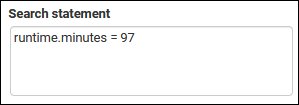
will return only the Manifestation record.
A search using the Expand operator (here we see the search statement in an Advanced search):

will return both records.
In a Standard search, select the Expand option to use the Expand operator:

Note that older versions of Collections provide a checkbox for the Expand option:

The short answer is the Expand operator: when performing a Standard or an Advanced search, the Expand operator makes it possible to search for records using one or more values inherited from a parent record (whether a field has been configured as inherited or not).
To demonstrate, the following hierarchy comprises 19 records:
Only the top record has values specified for Date (early) and Date (late):
This search will return only one record:

If we select the Expand option however, all 19 records will be returned:

This is a Boolean AND search and records are returned if:
- Reference Code begins with AC
And
- Date (early) is 1901
By selecting the Expand option the search is expanded to child records and empty fields are assumed to have inherited the value from a parent record.
If a field in a child record is not empty, the Expand option will respect this. For example, we add a different Date (early) to one of the records in the hierarchy:
Now when we repeat our expanded search, only 13 records are returned as 6 records in the hierarchy no longer match the search criteria.
-
(Optional) If you would like to know how many records will be returned by your search, select Count. A pop-up box will indicate how many records will be found.
- Select Find or press ENTER to run the search.
Any records returned by your search can be viewed in one or more of the Collections Display Views.
